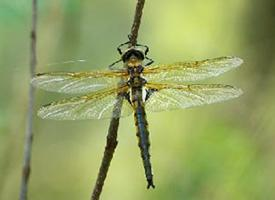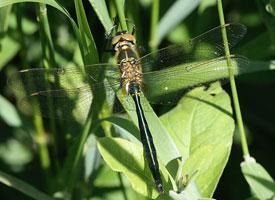
Poids et mesures
| Longueur | de 50 à 55 mm |
|---|---|
| Envergure des ailes | de 65 à 75 mm |
Description de l'animal
The Downy Emerald (Cordulia aenea) is a captivating species of dragonfly that is widely admired for its distinctive appearance and intriguing behaviors. This medium-sized dragonfly belongs to the family Corduliidae, often referred to as the Emeralds due to the characteristic metallic green coloring of many species within this group. The Downy Emerald, in particular, boasts a striking combination of colors and textures that make it a favorite among enthusiasts and naturalists.The adult Downy Emerald typically measures between 45 to 50 millimeters in length, with a robust and slightly hairy body that contributes to its common name. The thorax of this dragonfly is a deep, velvety green, covered in fine, downy hairs that give it a somewhat fuzzy appearance, especially when observed up close. This hairiness not only serves as insulation but also plays a role in the dragonfly's camouflage among the foliage where it often rests.
One of the most striking features of the Downy Emerald is its wings. The wings are transparent but have a conspicuous, rich bronze sheen that is particularly noticeable when they catch the light during flight. The wingspan can reach up to 70 millimeters, and the wings are held outstretched when the dragonfly is at rest, showcasing their beautiful metallic sheen. The wingtips are subtly darkened, adding to the overall elegance of the species.
The abdomen of the Downy Emerald is slender and segmented, with a metallic green coloration that can appear golden or coppery in different lighting conditions. Each segment is finely edged with black, creating a segmented appearance that is both intricate and delicate. The eyes of the Downy Emerald are large and compound, offering a wide field of vision that is essential for detecting prey and avoiding predators. The eyes are a deep green or sometimes bluish color, blending seamlessly with the rest of the body.
In terms of habitat, the Downy Emerald is typically found in and around freshwater environments, such as ponds, lakes, and slow-moving rivers, with a particular preference for wooded areas. These dragonflies are most active from late spring to early summer, during which time they can often be seen patrolling their territory or engaging in aerial acrobatics as they hunt for insects.
The life cycle of the Downy Emerald, like that of other dragonflies, includes both aquatic larval and airborne adult stages. The larvae, known as nymphs, are aquatic predators that inhabit the sediment and vegetation of freshwater bodies. After undergoing several molts, they emerge from the water to undergo metamorphosis, shedding their larval skin to reveal the adult dragonfly.
Despite their beauty and fascinating behaviors, Downy Emeralds, like many dragonfly species, face threats from habitat loss, pollution, and climate change. Conservation efforts are essential to ensure the survival of these remarkable insects and the ecosystems they inhabit.
In summary, the Downy Emerald (Cordulia aenea) is a stunning dragonfly species known for its velvety green thorax, bronze-tinted wings, and metallic green abdomen. Its presence adds a touch of magic to the freshwater habitats it frequents, making it a jewel among the dragonflies and a testament to the incredible diversity of the insect world.
Animaux similaires
Nouvelles photos d'animaux
Top 10 des animaux
- Dolphin gull (Leucophaeus scoresbii)
- Diana monkey (Cercopithecus diana)
- Moustached guenon (Cercopithecus cephus)
- Galápagos tortoise (Geochelone nigra complex)
- Russian tortoise (Testudo horsfieldii)
- Stone loach (Barbatula barbatula)
- Japanese macaque (Macaca fuscata)
- Greek tortoise (Testudo graeca)
- Common flying dragon (Draco volans)
- Vendace (Coregonus albula)


